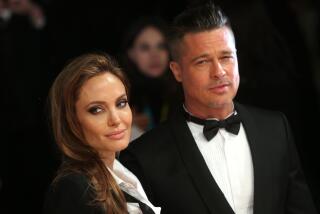Decoding Angelina Jolie’s double mastectomy and BRCA genes

- Share via
Angelina Jolie’s revelation that she underwent a preventative double mastectomy may seem like a shocking move to some. But for many women who have dangerous hereditary risks coded into their genes, this kind of surgery before cancer strikes serves as a viable alternative that’s been growing in popularity over the last few decades, doctors say.
For patients with a dangerous mutation in the BRCA1 or BRCA2 genes that dramatically raises their risk of breast cancer, there are a few options available to them, said Maureen Chung, a breast surgical oncologist and medical director of the Margie Petersen Breast Center at St. John’s Health Center in Santa Monica.
One is to keep close and constant watch of a patient’s breast tissue with mammograms and MRIs; this won’t prevent cancer from growing, but it will allow doctors to catch it and treat it faster, Chung said.
A second option would be to keep watch, while also throwing in a drug called tamoxifen, which reduces the risk of developing breast cancer. But this works only with certain types of cancer and may not have worked in Jolie’s case, Chung said.
Rather than sit and wait, she said, many women with an extremely high, hereditary risk of breast cancer choose the preventative route – a double mastectomy before breast cancer can take root.
“It’s not unreasonable,” Chung said. “It’s very common.”
Everyone has BRCA genes, Chung pointed out. The trouble is in mutated versions that for some reason are associated with very high risks of breast and ovarian cancer. But mutations can occur in different spots in a gene’s code, and not every mutation is created equal, Chung pointed out.
“Not everyone who has a BRCA1 mutation gets breast cancer -- and the question is, why?” Chung said. “Or, someone may have a BRCA1 gene mutation and get breast cancer at the age of 30. Someone else may have the same mutation and get it at the age of 50. Why? So there are obviously modifiers out there that we’re just beginning to learn about.”
Researchers are cataloging the mutations in the genes – but now the picture has become even more complicated, she said. Scientists are also looking at when and how often a gene is activated.
“Before, we were only focusing on whether you had a change in the sequence,” Chung said. “Now we’re beginning to focus on changes in the expression of that gene. So we’re getting a lot more sophisticated.”
But those women with extremely high risk of breast cancer – Jolie, whose dangerous mutation lay in the BRCA1 gene, wrote that her risk of developing breast cancer was a whopping 87% -- are not the only ones taking on double mastectomies as a preventative option, Chung noted. Increasingly, women who have a somewhat elevated risk for other reasons are also considering the surgery.
“That’s a number we’re seeing go up across the country over the last 10 years,” Chung said. “And we’re not quite certain why. We think it’s because there’s more awareness of breast cancer … but we’re also getting better in terms of reconstruction.”
Surgeons can now leave the nipple and the breasts’ envelope of skin intact and fill it with an implant, Chung said -- though this comes with a little risk, as a tiny bit of breast tissue will be left behind.
Regardless, she added, even a mastectomy that doesn’t spare any part of the breast for reconstruction won’t entirely eliminate the risk: Patients can still potentially develop breast cancer in nearby areas, such as the armpit or the chest wall.
Follow me on Twitter @aminawrite.







